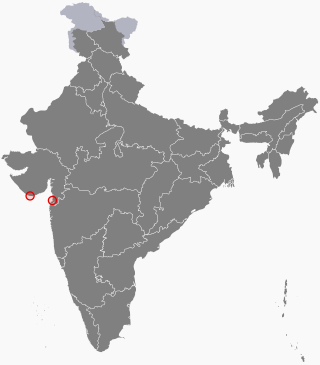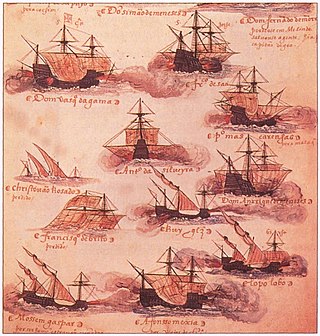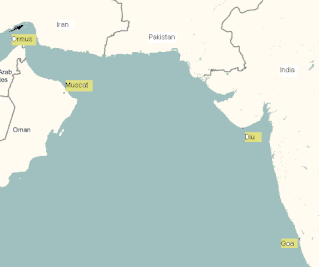The Sán Dìu are a Yao ethnic group in northern Vietnam who speak Yue Chinese (Cantonese), a Sinitic language. They are believed to have migrated from Guangdong, China around 1600.

Daman and Diu was a union territory in northwestern India. With an area of 112 km2 (43 sq mi), it was the smallest administrative subdivision of India on the mainland. The territory comprised two districts, Daman and Diu island, geographically separated by the Gulf of Khambat. The state of Gujarat and the Arabian Sea bordered the territory. A Portuguese colony since the 1500s, the territories were taken by India with the Annexation of Goa in 1961. Daman and Diu were administered as part of the union territory of Goa, Daman and Diu between 1961 and 1987, after the Goa Opinion Poll they became a separate union territory. In 2019, legislation was passed to merge the union territory of Daman and Diu with its neighbouring union territory, Dadra and Nagar Haveli, to form the new union territory of Dadra and Nagar Haveli and Daman and Diu with effect from 26 January 2020.

The Battle of Diu was a naval battle fought on 3 February 1509 in the Arabian Sea, in the port of Diu, India, between the Portuguese Empire and a joint fleet of the Sultan of Gujarat, the Mamlûk Burji Sultanate of Egypt, and the Zamorin of Calicut with support of the Republic of Venice and the Ottoman Empire.

Qutb-ud-Din Bahadur Shah, born Bahadur Khan was a sultan of the Muzaffarid dynasty who reigned over the Gujarat Sultanate, a late medieval kingdom in India from 1526 to 1535 and again from 1536 to 1537. He ascended to the throne after competing with his brothers. He expanded his kingdom and made expeditions to help neighbouring kingdoms. In 1532, Gujarat came under attack of the Mughal Emperor Humayun and fell. Bahadur Shah regained the kingdom in 1536 but he was killed by the Portuguese on board a ship when making a deal with them.

Dom João de Castro was a Portuguese nobleman, scientist, writer, and the fourth viceroy of Portuguese India. He was called Castro Forte by the poet Luís de Camões. De Castro was the second son of Álvaro de Castro, the civil governor of Lisbon. His wife was Leonor de Coutinho.

Diu, also known as Diu Town, is a medieval fortified town in Diu district in the union territory of Dadra and Nagar Haveli and Daman and Diu, India. Diu district is the tenth least populated district of India. The town of Diu lies at the eastern end of Diu Island and is known for its fortress and old Portuguese cathedral. It is a fishing town.

Diu Airport is a domestic airport serving Diu in the union territory of Dadra and Nagar Haveli and Daman and Diu, India. Besides Diu, it also serves the neighbouring areas of Gujarat, including Veraval and Jafrabad. It is the only airport in the union territory with commercial operations.

The Diu Fortress is a Portuguese-built fortification located on the west coast of India in Diu. The fortress was built as part of Portuguese India's defensive fortifications at the eastern tip of the island of Diu during the 16th century. The fortress, which borders on the town of Diu, was built in 1535 subsequent to a defense alliance forged by Bahadur Shah, the Sultan of Gujarat and the Portuguese when Humayun, the Mughal Emperor attempted to annex this territory. It was strengthened over the years, till 1546. The Portuguese ruled over this territory from 1537 until the Indian invasion of December 1961. Today it is a landmark of Diu and one of the Seven Wonders of Portuguese Origin in the World.

The siege of Diu occurred when an army of the Sultanate of Gujarat under Khadjar Safar, aided by forces of the Ottoman Empire, attempted to capture the city of Diu in 1538, then held by the Portuguese. The Portuguese successfully resisted the four months long siege. It is part of the Ottoman-Portuguese war.

The Battle of Chaul was a naval battle between the Portuguese and an Egyptian Mamluk fleet in 1508 in the harbour of Chaul in India. The battle ended in a Mamluk victory. It followed the Siege of Cannanore in which a Portuguese garrison successfully resisted an attack by Southern Indian rulers. This was the first Portuguese defeat at sea in the Indian Ocean.
Hoca Sefer was an Ottoman captain in charge of pro-Ottoman forces in Gujarat in the first half of the 16th century. Hoca Sefer, who had been installed by the Ottoman captain Selman Reis, attempted to maintain Ottoman influence in Diu against the Portuguese, who had established the Diu Fort there. The conflict between the Ottomans and the Portuguese would escalate with the Siege of Diu in 1538, following the request for Ottoman intervention by Sultan Bahadur Shah of Gujarat in 1536.

Egyptian Mamluk–Portuguese conflicts refers to the armed engagements between the Egyptian state of the Mamluks and the Portuguese in the Indian Ocean, following the expansion of the Portuguese after sailing around the Cape of Good Hope in 1498. The conflict took place during the early part of the 16th century, from 1505 to the fall of the Mamluk Sultanate in 1517.

The third siege of Diu was a siege of the Portuguese Indian city of Diu by the Gujarat Sultanate in 1546. It ended with a major Portuguese victory.
The siege of Diu occurred when a combined Ottoman-Gujarati force defeated a Portuguese attempt to capture the city of Diu in 1531. The victory was partly the result of Ottoman firepower over the Portuguese besiegers deployed by Mustafa Bayram, an Ottoman expert.
Events from the year 1531 in India.
Events from the year 1546 in India.
Events from the year 1538 in India.
Mustafa Bayram was from Yemen and Selman Reis' nephew. After Selman Reis fell into a dispute with Hayreddin al-Rumi in 1528, he was murdered later on by al-Rumi. The two had fights because Selman Reis was relieved of the duty to lead the Ottoman Navy in the Red Sea and Indian Ocean. However he refused to step down and continued to lead the navy. Nonetheless, the post had been given to al-Rumi. Before Selman Reis was killed, he had given an order to Mustafa Bayram and Hoca Sefer. Under Mustafa Bayram's supervision, they would go to Diu and help Bahadur Shah of Gujarat to fight against the Portuguese Empire.










